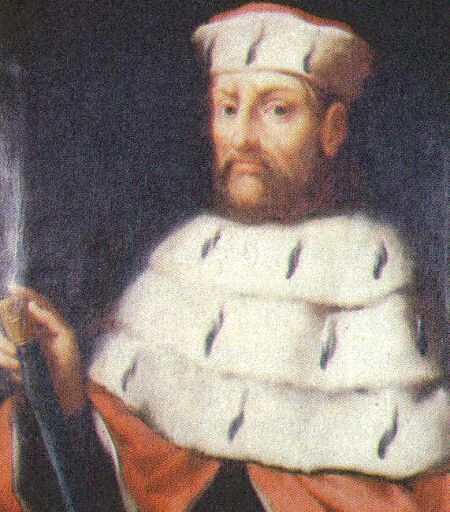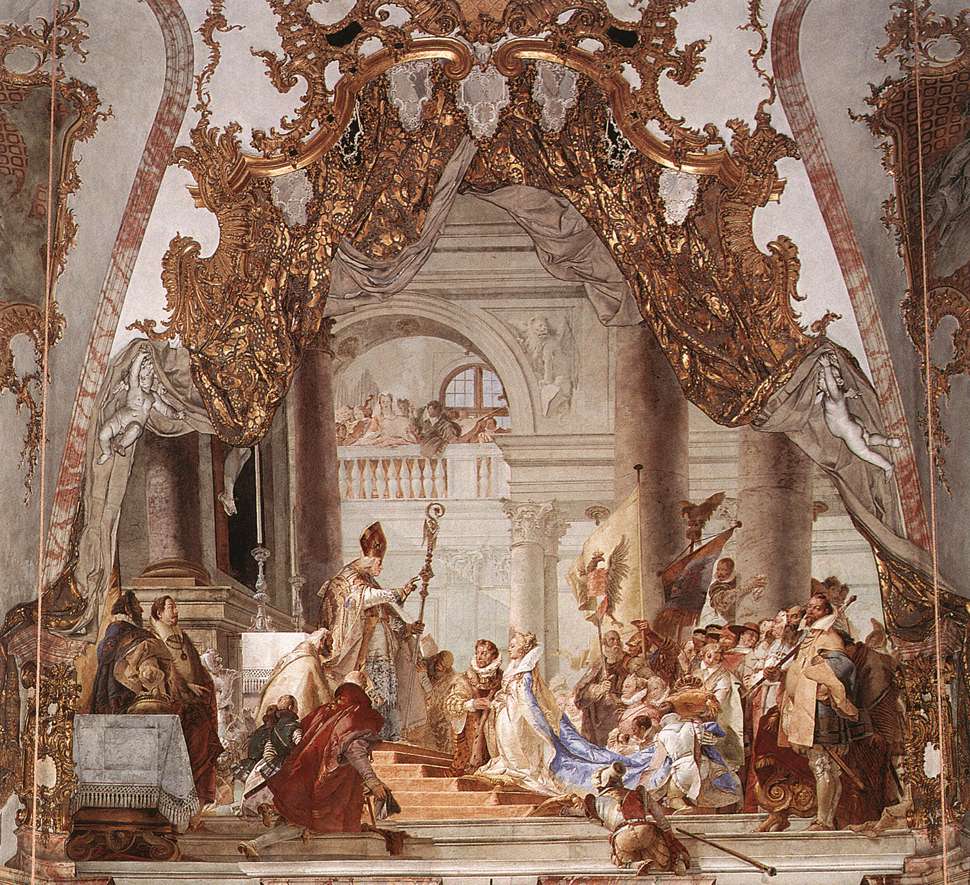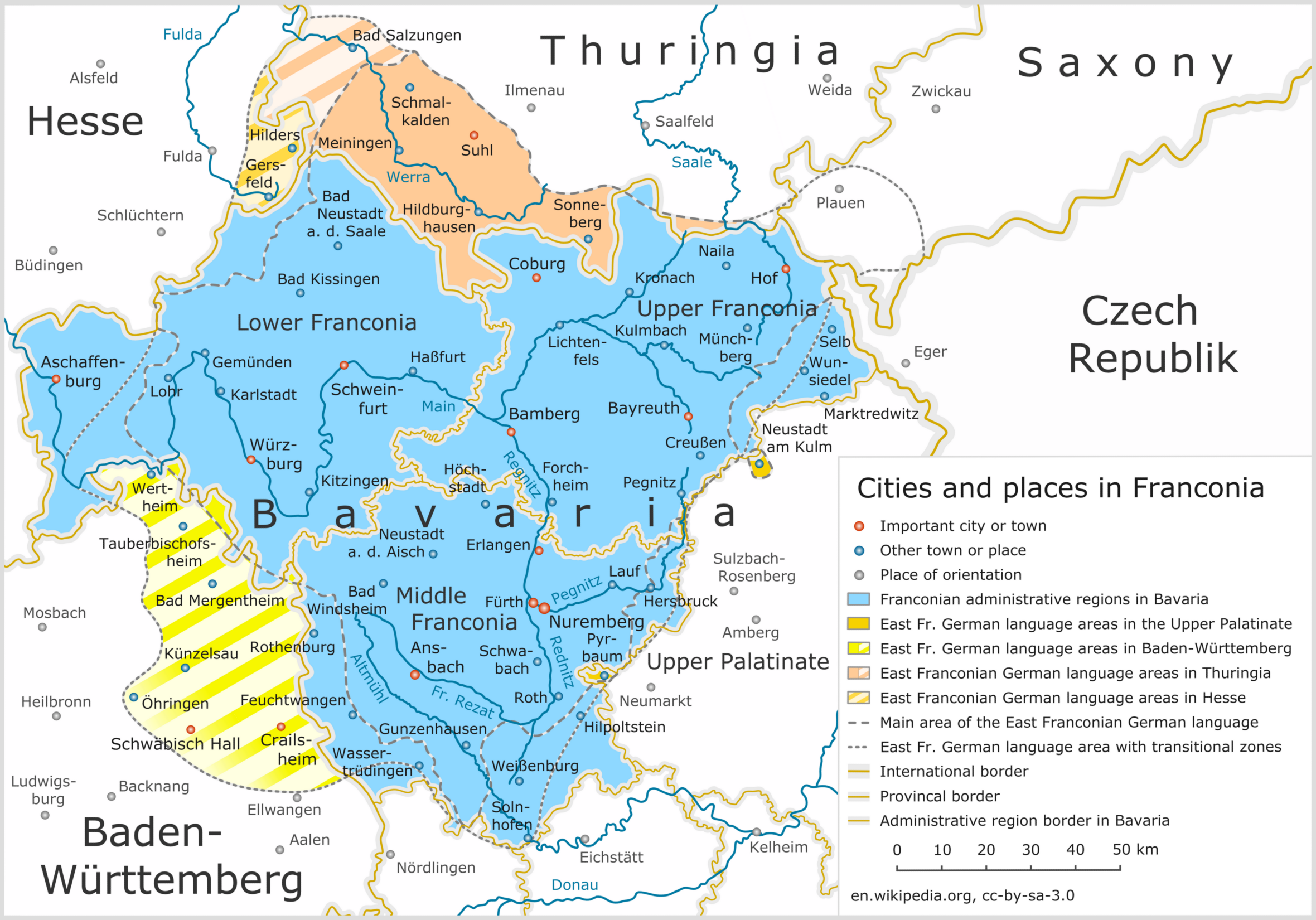|
Hermann Von Stahleck
Hermann von Stahleck (died 2 October 1156) was the son of Count Goswin von Stahleck and Luitgard von Heimbach. He was Count Palatine of the Rhine from 1142/43 until his death. Hermann inherited property from his father in eastern Franconia with the title of Count of Bildhausen (today a district of Münnerstadt) as well as in Höchstadt. His mother's inheritance probably included properties around Stahleck Castle. Although he was already appears powerful and influential as the sole heir to his father's numerous castles and estates, his reputation and lands were to be significantly increased by his marriage to Gertrud von Staufen, a sister of King Conrad and Frederick II of Swabia. In 1142/1143 he was made Count Palatine of the Rhine by his brother-in-law king Conrad III, after the previous holder of that title, Henry II Jasomirgott had taken over the Margraviate of Austria. Hermann was also made vogt of the Archbishopric of Trier shortly afterwards. Hermann maintained his title ag ... [...More Info...] [...Related Items...] OR: [Wikipedia] [Google] [Baidu] |
Count Palatine Of The Rhine
This article lists counts palatine of Lotharingia, counts palatine of the Rhine, and electors of the Palatinate (), the titles of three counts palatine who ruled some part of the Rhine region in the Kingdom of Germany and the Holy Roman Empire between 915 and 1803. From 1261 (formally 1356), the title holder was a member of the small group of prince-electors who elected the emperor of the Holy Roman Empire. Since then, the title has also been referred to as " Elector Palatine". Counts palatine of Lotharingia, 915–1085 The Palatinate emerged from the County Palatine of Lotharingia which came into existence in the 10th century. * Wigeric of Lotharingia, count of the Bidgau ( 915/916–922) * Godfrey, count of the Jülichgau (c. 940) House of Ezzonen During the 11th century, the Palatinate was dominated by the Ezzonian dynasty, which governed several counties on both banks of the Rhine. These territories were centered around Cologne-Bonn, but extended south to the river ... [...More Info...] [...Related Items...] OR: [Wikipedia] [Google] [Baidu] |
Otto I, Count Of Salm
Otto I, Count of Salm ( – 1150) was a German nobleman. He was a ruling count of Salm and from 1125 to 1137, he was co-ruler of the County Palatine of the Rhine with his stepson William. Life His parents were the German anti-king Hermann of Salm and his wife Sophia of Formbach. Around 1115, he married Gertrude, the widow of Count Palatine Siegfried of Ballenstedt, daughter and heir of Henry, Margrave of Frisia and Gertrude of Brunswick. Gertrude was also the sister of Richenza of Northeim, the consort of Emperor Lothair III. Otto constructed Rheineck Castle and from , he styled himself ''Otto of Rheineck'', after his castle. After his stepson Count Palatine William of the Rhine had died in 1140, he claimed the County Palatine of the Rhine. However, King Conrad III of Germany, who had been elected in 1138, decided that the County Palatine was a completed fief, and hence fell back to the King, who gave it to his brother-in-law and devoted supporter Hermann von ... [...More Info...] [...Related Items...] OR: [Wikipedia] [Google] [Baidu] |
1156 Deaths
Year 1156 ( MCLVI) was a leap year starting on Sunday of the Julian calendar. Events By place Levant * Spring – Raynald of Châtillon, prince of Antioch, makes an alliance with Thoros II (the Great), ruler of Armenian Cilicia. He invades Cyprus and conducts a widespread plundering of the Byzantine island. The Crusaders and the Armenian forces march up and down the island robbing and pillaging every building, church and convent as well as shops and private houses. The crops are burnt; the herds are rounded up – together with all the population – and driven down to the coast. The massacre lasts about three weeks; on the rumor of a Byzantine fleet in the offing, Raynald gives the order for embarkation. The Crusader ships are loaded with booty, and every Cypriot is forced to ransom himself. Europe * January 20 – Freeholder Lalli slays the English missionary-bishop Henry with an axe, on the ice of Lake Köyliönjärvi in Finland (according to legend ... [...More Info...] [...Related Items...] OR: [Wikipedia] [Google] [Baidu] |
Conrad, Count Palatine Of The Rhine
Conrad of Hohenstaufen ( – 8 November 1195) was the first hereditary Count Palatine of the Rhine. His parents were Frederick II of Swabia (1090–1147), Duke of Swabia, and his second wife Agnes of Saarbrücken, daughter of Frederick, Count of Saarbrücken. Young Conrad, the only half-brother of Frederick Barbarossa, received the family's possessions around Franconia and Rhineland, particularly those of his mother's ancestry. In 1156 on the occasion of the '' Reichstag'' at Worms, Emperor Frederick Barbarossa conferred upon his half-brother the dignity of ''Pfalzgraf'' (Count Palatine, of the Rhine), as well as the ''Vogtei'' of Schönau Abbey and of the chapter of Worms Cathedral, besides the Staufen family estates in the regions of Speyer and Worms. From about 1160 Conrad was married to Irmengard of Henneberg (d. 1197) as his second wife, daughter of Count Bertold I of Henneberg, '' Burggraf'' of Würzburg. This brought him the possession of the ''Vogtei'' of Lorsch Abb ... [...More Info...] [...Related Items...] OR: [Wikipedia] [Google] [Baidu] |
Ebrach Abbey
Ebrach Abbey () is a former Cistercian monastery in Ebrach in Oberfranken, Bavaria, Germany, and the site of a young offenders' institution. History Abbey The abbey, dedicated to the Virgin Mary, Saint John the Evangelist and Saint Nicholas, was founded in 1127, as the oldest house of the Cistercian order in Franconia. The founder, i.e. the provider of land, was a local noble named Berno. The involvement of other founders named in historic documents, such as King Konrad III, is doubtful. Berno's supposed siblings, Richwin and Berthrade, may also not have existed. The abbey was settled by twelve monks from Morimond Abbey in Burgundy, under the first abbot, Adam of Ebrach. The first church was dedicated in 1134, however, this was completely replaced later. The monks were active in viticulture, forestry, and keeping sheep. The monastery became one of the wealthiest in Franconia. Gertrude von Sulzbach, King Konrad's wife, was buried at the abbey upon her death in 1146. Cons ... [...More Info...] [...Related Items...] OR: [Wikipedia] [Google] [Baidu] |
Cistercians
The Cistercians (), officially the Order of Cistercians (, abbreviated as OCist or SOCist), are a Catholic religious order of monks and nuns that branched off from the Benedictines and follow the Rule of Saint Benedict, as well as the contributions of the highly influential Bernard of Clairvaux, known as the Latin Rule. They are also known as Bernardines, after Bernard of Clairvaux, Saint Bernard, or as White Monks, in reference to the colour of their cowl, as opposed to the black cowl worn by Benedictines. The term ''Cistercian'' derives from ''Cistercium,'' the Latin name for the locale of Cîteaux, near Dijon in eastern France. It was here that a group of Benedictine monks from the monastery of Molesme Abbey, Molesme founded Cîteaux Abbey in 1098. The first three abbots were Robert of Molesme, Alberic of Cîteaux and Stephen Harding. Bernard helped launch a new era when he entered the monastery in the early 1110s with 30 companions. By the end of the 12th century, the ord ... [...More Info...] [...Related Items...] OR: [Wikipedia] [Google] [Baidu] |
Frederick Barbarossa
Frederick Barbarossa (December 1122 – 10 June 1190), also known as Frederick I (; ), was the Holy Roman Emperor from 1155 until his death in 1190. He was elected King of Germany in Frankfurt on 4 March 1152 and crowned in Aachen on 9 March 1152. He was crowned King of Italy on 24 April 1155 in Pavia and emperor by Pope Adrian IV on 18 June 1155 in Rome. Two years later, the term ' ("holy") first appeared in a document in connection with his empire. He was later formally crowned King of Burgundy, at Arles on 30 June 1178. His nickname of ' (meaning "Red Beard" in Italian) "was first used by the Florentines only in 1298 to differentiate the emperor from his grandson, Frederick II ... and was never employed in medieval Germany" (the colour red was "also associated in the Middle Ages with malice and a hot temper"; in reality, Frederick's hair was "blond", although his beard was described by a contemporary as "reddish"). In German, he was known as ', which in English means " ... [...More Info...] [...Related Items...] OR: [Wikipedia] [Google] [Baidu] |
Wendish Crusade
The Wendish Crusade () was a military campaign in 1147, one of the Northern Crusades, led primarily by the Kingdom of Germany within the Holy Roman Empire and directed against the Polabian Slavs (or "Wends"). The Wends were made up of the Slavic tribes of Abrotrites, Rani, Liutizians, Wagarians, and Pomeranians who lived east of the River Elbe in present-day northeast Germany and Poland. The lands inhabited by the Wends were rich in resources, which played a factor in the motivations of those who participated in the crusade. The mild climate of the Baltic area allowed for the cultivation of land and livestock. Animals of this region were also thickly furred, supporting the dependence on fur trading. Access to the coastline also developed fishing and trade networks. The land was attractive for the resources it boasted, and the crusade offered an opportunity for noble families to gain part of it. By the early 12th century, the German archbishoprics of Bremen and Magdeburg sough ... [...More Info...] [...Related Items...] OR: [Wikipedia] [Google] [Baidu] |
Archbishopric Of Trier
The Diocese of Trier (), in English historically also known as ''Treves'' () from French ''Trèves'', is a Latin Church ecclesiastical territory or diocese of the Catholic church in Germany."Diocese of Trier" ''Catholic-Hierarchy.org''. David M. Cheney. Retrieved February 29, 2016"Diocese of Trier" ''GCatholic.org''. Gabriel Chow. Retrieved February 29, 2016 When it was the archbishopric and Electorate of Trier, it was one of the most important states of the Holy Roman Empire, both as an ecclesiastical principality and as a diocese of the church. Unlike the other Rhenish dioceses—including Roman Catholic Diocese of Mainz, Mainz and Roman Catholic Archdiocese o ... [...More Info...] [...Related Items...] OR: [Wikipedia] [Google] [Baidu] |
Franconia
Franconia ( ; ; ) is a geographical region of Germany, characterised by its culture and East Franconian dialect (). Franconia is made up of the three (governmental districts) of Lower Franconia, Lower, Middle Franconia, Middle and Upper Franconia in Bavaria, the adjacent, East Franconian, Franconian-speaking South Thuringia, south of the Thuringian Forest—which constitutes the language boundary between Franconian and Thuringian—and the eastern parts of Heilbronn-Franconia in Baden-Württemberg. Those parts of the Vogtland lying in Saxony (largest city: Plauen) are sometimes regarded as Franconian as well, because the Vogtlandian dialects are mostly East Franconian. The inhabitants of Saxon Vogtland, however, mostly do not consider themselves Franconian. On the other hand, the inhabitants of the Hessian dialect, Hessian-speaking parts of Lower Franconia west of the Spessart (largest city: Aschaffenburg) do consider themselves Franconian, although not speaking the dialect. He ... [...More Info...] [...Related Items...] OR: [Wikipedia] [Google] [Baidu] |





